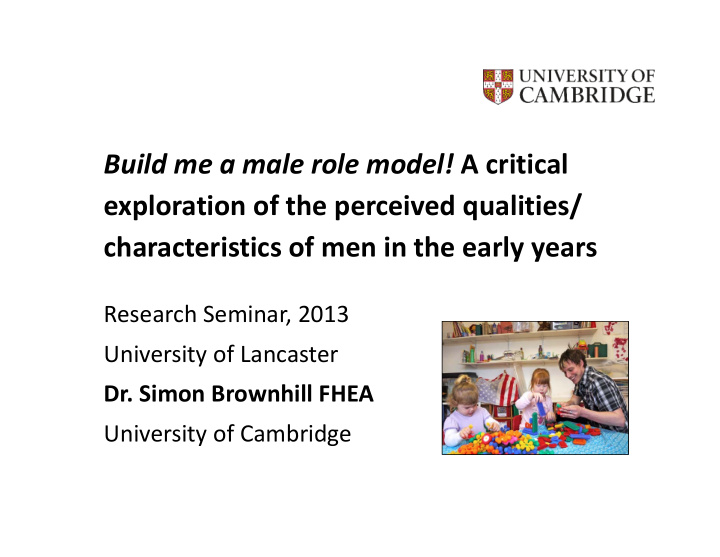



Build me a male role model! A critical exploration of the perceived qualities/ characteristics of men in the early years Research Seminar, 2013 University of Lancaster Dr. Simon Brownhill FHEA University of Cambridge
‘The main drivers’ The ‘feminisation’ The ‘gender gap ’ of teaching (Carrington et al . (Skelton, 2009: 39) 2007: 397) ‘Strong male Father figures role models ’ (Ivens, 2008) (Parkin, 2009)
‘Common-sense truth claims’ • ‘ If boys see men reading books and doing lots of neat writing, then boys will avidly read books and produce volumes of neat writing ’ (Ashley, 2002: 1) • Making schools and settings ‘ boy friendly again ’ (McPhee, 2007: 35) • The ‘replacement father’ who can relate , support , model and provide better for boys (Skelton, 2002) • ‘...inspir[ing] children to feel more confident , work harder and behave better ’ (Bryon, 2008)
Existing tensions • The ‘soft pedagogical practices of females’ (Odih, 2002: 91) • The deficient upbringing of children with no ‘stable male’ (Jones, 2008: 694) • ‘ Women…as the problem and men as the solution ’ (Smedley, 1998 cited in Mills et al. 2004: 361) • ‘Role model’ – a diversity of meanings (Sargent, 2001: 118)
The Research • Research Aim: To critically explore perceived qualities/characteristics of male role models for boys in the early years (0-8 years) • Research questions: Rank ordering and identifying additional qualities/characteristics • Participants: Men who worked/trained in a variety of roles with children in 0-8 settings in a central county in the Midlands, UK
Research Strategy Paradigm location Methodological approach Interpretivist Mixed method • 174 questionnaires (48% return) S1 • Males training/working directly with children (0-8) • 1 focus group interview S2 • 3 males at an operational level in schools (5-8) • 6 semi-structured interviews S3 • Exploring lines of enquiry/areas of interest (S1/2)
Building a profile A father figure Emotional Kind Reliable Able to Good sense of demonstrate Professionally An authoritative humour positive attitudes committed figure towards learning A nurturer Good at writing Trustworthy Work orientated Intelligent Athletic Generous Aggressive Good at sports Respectful Charismatic A disciplinarian
Building a profile A father figure Emotional Kind Reliable Able to Good sense of demonstrate Professionally An authoritative humour positive attitudes committed figure towards learning A nurturer Good at writing Trustworthy Work orientated Intelligent Athletic Generous Aggressive Good at sports Respectful Charismatic A disciplinarian
Building a profile A father figure Emotional Kind Reliable Able to Good sense of demonstrate Professionally An authoritative humour positive attitudes committed figure towards learning A nurturer Good at writing Trustworthy Work orientated Intelligent Athletic Generous Aggressive Good at sports Respectful Charismatic A disciplinarian
Building a profile A father figure Emotional Kind Reliable Able to Good sense of demonstrate Professionally An authoritative humour positive attitudes committed figure towards learning A nurturer Good at writing Trustworthy Work orientated Intelligent Athletic Generous Aggressive Good at sports Respectful Charismatic A disciplinarian
Building a profile Rank order Quality/characteristic position 1 Reliable/Able to demonstrate positive attitudes towards learning 2 Trustworthy 3 Kind 4 Respectful 5 Good sense of humour
Additional qualities/characteristics Good listener (n12) Fair (n9) Approachable (n7) Honest (n5) Consistent (n4) Supportive (n4) Being themselves (n3) Understanding (n2)
Qualities/characteristics: categories ‘Being real’ – in touch ‘Empathetic’ – with reality compassionate ‘Skilled’ – practical ‘Leadership’ – problem solving responsible ‘Virtues’ – fair ‘Dispositions’ – warm Personality traits – Physical appearance – playful smart clothes Additional – popular, successful
Discussion • Most qualities/characteristics were associated with personal ‘good person’ attributes e.g. trustworthy and respectful • The need for the male role model to have a ‘good sense of humour’ • Emulation of professional characteristics • The androgynous nature of many identified qualities/characteristics
Discussion • Qualities/characteristics are shaped by context , situation and the expectations of others e.g. parents, colleagues and children • Qualities/characteristics that emulate the ‘millennium man’ (Jones, 2007: 192) • The importance of qualities/characteristics that are natural to the role model – danger of those which are forced or ‘artificial’
Conclusions • No two role models are the same – different contexts, situations and expectations seek different requirements of the role model • The pressure on male role models to emulate different qualities/characteristics • The negative impact of the role model on those children who are repelled by the emulation of ‘fake’ or ‘false’ qualities/characteristics • ‘General lack of clarity’ (Jones, 2006: 71)
Any questions or comments?
See Chapter 9: WHERE ARE THE MEN? by Guy Roberts- Holmes and Simon Brownhill for ‘a critical discussion about male absence in the early years’ in the following book: Miller, L. and Cable, C. ( eds. ) (2011) Professionalization, Leadership and Management in the Early Years . London: Sage Publications. Please also visit http://www.bbc.co.uk/news/education-13600611
Contact details • Name: Dr. Simon Brownhill FHEA • Role: Senior Teaching Associate • Address: University of Cambridge Trumpington House, Room 1 184 Hills Road Cambridge CB2 8PQ • Email: spb55@cam.ac.uk • Tel: 01223 767646
Recommend
More recommend